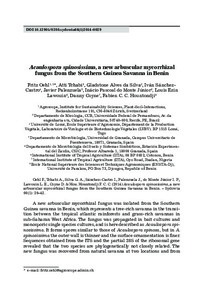| dc.contributor.author | Oehl, F. |
| dc.contributor.author | Tchabi, A. |
| dc.contributor.author | Silva, G.A. |
| dc.contributor.author | Sanchez-Castro, I. |
| dc.contributor.author | Palenzuela, J. |
| dc.contributor.author | Monte Junior, I.P. do |
| dc.contributor.author | Lawouin, L. |
| dc.contributor.author | Coyne, D.L. |
| dc.contributor.author | Hountondji, F.C.C. |
| dc.date.accessioned | 2019-12-04T10:58:31Z |
| dc.date.available | 2019-12-04T10:58:31Z |
| dc.date.issued | 2014 |
| dc.identifier.citation | Oehl, F., Tchabi, A., Silva, G.A., Sanchez-Castro, I., Palenzuela, J., do Monte Junior, I.P., … & Hountondji, F. (2014). Acaulospora spinosissima, a new arbuscular mycorrhizal fungus from the Southern Guinea Savanna in Benin. Sydowia, 66, 29-42. |
| dc.identifier.issn | 0082-0598 |
| dc.identifier.uri | https://hdl.handle.net/20.500.12478/1006 |
| dc.description.abstract | A new arbuscular mycorrhizal fungus was isolated from the Southern Guinea savanna in Benin, which represents a tree-rich savanna in the transi-tion between the tropical atlantic rainforests and grass-rich savannas in sub-Saharan West Africa. The fungus was propagated in bait cultures and monosporic single species cultures, and is here described as Acaulospora spi-nosissima. It forms spores similar to those of Acaulospora spinosa, but in A. spinosissima the outer wall is thinner and the surface ornamentation is finer. Sequences obtained from the ITS and the partial 28S of the ribosomal gene revealed that the two species are phylogenetically not closely related. The new fungus was recovered from natural savanna at two locations and from Acaulospora spinosissima, sp. nov.one field site under yam cultivation in the first year after tree clearance. It was not detected in agricultural field sites cultivated for more than one year.Keywords: Glomeromycota, taxonomy, arbuscular mycorrhiza, savan-nas, biodiversity.Spore surface ornamentation is a common feature for species of arbus-cular mycorrhizal (AM) fungi in the family Acaulosporaceae (Tab. 1). Cur-rently there are 15 species described with a pitted spore surface (e.g. Trappe 1977, Oehl et al. 2011, Furrazola et al. 2013), two species having pits beneath spiny projections (Gerdemann & Trappe 1974, Rothwell & Trappe 1979), one species with pits on top of projections (Sieverding & Toro 1987), and eight species with spiny to pustulate projections without any other ornamentation on the same spore wall (Walker & Trappe 1981, Janos & Trappe 1982, Palen-zuela et al. 2013, Cai et al. 2013). ). There are also 20 species with smooth to rugulate spore surfaces (e.g. Gerdemann & Trappe 1974, Schenck et al. 1984, Morton 1986, B?aszkowski 1988 a, 1995, 2012, Oehl et al. 2012).In recent years, remarkable progress has been achieved regarding the identification and description of Acaulospora species with pitted spore sur-faces (e.g. B?aszkowski 1988 b, 1989, 2012, Oehl et al. 2006, 2012), also due to advances made in molecular phylogenetic analyses. However, clear morpho-logical identification of species with smooth spore surfaces or projections on the spore surface has remained difficult because of the lack of clearly dif-ferentiating features (Palenzuela et al. 2014).In the current study we describe a new AM fungus that has projections on the spore surface, which superficially resemble those of A. spinosa and A. tuberculata. Molecular analyses on the ribosomal gene clearly separated the fungus from both these species phylogenetically, positioning it near to A. herrerae and A. kentinensis. |
| dc.format.extent | 029-042 |
| dc.language.iso | en |
| dc.subject | Taxonomy |
| dc.subject | Arbuscular Mycorrhiza |
| dc.subject | Savannas |
| dc.subject | Biodiversity |
| dc.title | Acaulospora spinosissima, a new arbuscular mycorrhizal fungus from the Southern Guinea Savanna in Benin |
| dc.type | Journal Article |
| dc.description.version | Peer Review |
| cg.contributor.affiliation | Institute for Sustainability Sciences, Zürich |
| cg.contributor.affiliation | Universidade Federal de Pernambuco |
| cg.contributor.affiliation | Université de Lomé |
| cg.contributor.affiliation | Universidad de Granada |
| cg.contributor.affiliation | Estación Experimen-tal del Zaidín, Spain |
| cg.contributor.affiliation | International Institute of Tropical Agriculture |
| cg.contributor.affiliation | Université de Parakou |
| cg.coverage.region | Africa |
| cg.coverage.region | West Africa |
| cg.coverage.country | Nigeria |
| cg.isijournal | ISI Journal |
| cg.authorship.types | CGIAR and developing country institute |
| cg.iitasubject | Plant Diseases |
| cg.journal | Sydowia |
| cg.howpublished | Formally Published |
| cg.accessibilitystatus | Limited Access |
| local.dspaceid | 77935 |
| cg.identifier.doi | https://dx.doi.org/10.12905/0380.sydowia66(1)2014-0029 |

